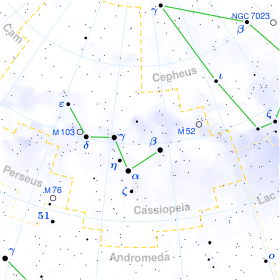HR 273
HR 273 is a chemically peculiar spectroscopic binary system in the northern circumpolar constellation of Cassiopeia. It has an apparent visual magnitude of 5.9 making it faintly visible to the naked eye from dark suburban skies. Parallax measurements with the Hipparcos spacecraft put this system at a distance of roughly 350 light years.[1]
| Observation data Epoch 2000 Equinox 2000 | |
|---|---|
| Constellation | Cassiopeia |
| Right ascension | 00h 58m 31.06245s[1] |
| Declination | +66° 21′ 06.4522″[1] |
| Apparent magnitude (V) | 5.97[2] |
| Characteristics | |
| Spectral type | A0 III[3] |
| U−B color index | −0.13[2] |
| B−V color index | −0.02[2] |
| Astrometry | |
| Radial velocity (Rv) | −10.3[4] km/s |
| Proper motion (μ) | RA: +43.81[1] mas/yr Dec.: −13.62[1] mas/yr |
| Parallax (π) | 9.31 ± 0.33[1] mas |
| Distance | 350 ± 10 ly (107 ± 4 pc) |
| Absolute magnitude (MV) | 0.3[5] |
| Orbit[6] | |
| Period (P) | 6.82054 days |
| Eccentricity (e) | 0 |
| Inclination (i) | 20.5° |
| Semi-amplitude (K1) (primary) | 24.60 km/s |
| Semi-amplitude (K2) (secondary) | 38.43 km/s |
| Details | |
| A | |
| Mass | 2.5[6] M☉ |
| Surface gravity (log g) | 4.0[7] cgs |
| Temperature | 11,400[7] K |
| B | |
| Surface gravity (log g) | 4.5[7] cgs |
| Temperature | 7,800[7] K |
| Rotational velocity (v sin i) | 3.2+0.3 −1.9[7] km/s |
| Other designations | |
| Database references | |
| SIMBAD | data |
The primary, HR 273 A, is an Ap star[8] and the secondary is an Am star, making this a very unusual binary system. The primary has a magnetic field of 65 gauss, amongst the weakest seen in any Ap star. The magnetic field in the secondary is too weak to detect.[7]
Component A has a spectral type of A0 III, and has unusually strong lines of strontium, chromium, and europium so it is known as a SrCrEu star.[6] Although some spectral lines of the secondary star can be clearly distinguished, its spectral type cannot be clearly assigned. It is thought to be a late class A star, cooler than the primary. The primary star has been rotationally braked so that its rotational period closely matches its orbital period.[7]
References
- van Leeuwen, F. (November 2007). "Validation of the new Hipparcos reduction". Astronomy and Astrophysics. 474 (2): 653–664. arXiv:0708.1752. Bibcode:2007A&A...474..653V. doi:10.1051/0004-6361:20078357.
- Ducati, J. R. (2002). "VizieR Online Data Catalog: Catalogue of Stellar Photometry in Johnson's 11-color system". CDS/ADC Collection of Electronic Catalogues. 2237. Bibcode:2002yCat.2237....0D.
- Cowley, A.; Cowley, C.; Jaschek, M.; Jaschek, C. (1969). "A study of the bright a stars. I. A catalogue of spectral classifications". Astronomical Journal. 74: 375. Bibcode:1969AJ.....74..375C. doi:10.1086/110819.
- Wilson, Ralph Elmer (1953). "General catalogue of stellar radial velocities". Washington. Bibcode:1953GCRV..C......0W.
- Gomez, A. E.; Luri, X.; Grenier, S.; Figueras, F.; North, P.; Royer, F.; Torra, J.; Mennessier, M. O. (1998). "The HR-diagram from HIPPARCOS data. Absolute magnitudes and kinematics of BP - AP stars". Astronomy and Astrophysics. 336: 953. Bibcode:1998A&A...336..953G.
- Carrier, F.; North, P.; Udry, S.; Babel, J. (2002). "Multiplicity among chemically peculiar stars. II. Cool magnetic Ap stars". Astronomy and Astrophysics. 394: 151. arXiv:astro-ph/0208082. Bibcode:2002A&A...394..151C. doi:10.1051/0004-6361:20021122.
- Alecian, E.; Tkachenko, A.; Neiner, C.; Folsom, C. P.; Leroy, B. (2016). "The magnetic field of the double-lined spectroscopic binary system HD 5550". Astronomy & Astrophysics. 589: A47. arXiv:1601.07762. Bibcode:2016A&A...589A..47A. doi:10.1051/0004-6361/201527355.
- Renson, P.; Manfroid, J. (2009). "Catalogue of Ap, Hg Mn and Am stars" (PDF). Astronomy and Astrophysics. 498 (3): 961. Bibcode:2009A&A...498..961R. doi:10.1051/0004-6361/200810788.
